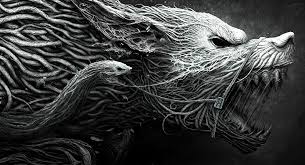
In the opening decades of the twenty-first century, with Trump in the White House and Brexit on the horizon, Angela Carter’s famous assertion of 1974 that ‘we live in Gothic times’ has never been more apt. This theme of ‘Gothic Times’ was addressed earlier this month at Gothic Manchester Festival symposium. The supernatural and paranormal have always been a means of figuring powers that cannot otherwise find visible expression. Contemporary anxieties and dissents are now being reassembled and re-presented as hauntings, shadows or phantoms – a nod to Marx, perhaps, who used the image of spectrality, a gothic phantom haunting Europe, in the Communist Manifesto (1848).
Since 2015 there have been increased reports of werewolf activity in the UK which point to our living in gothic times. The myth of Old Stinker, an eight-foot werewolf with a human face and very bad breath (supposedly from eating corpses) has re-emerged in Hull and there is renewed interest in the Dogdyke werewolf of Lincolnshire. This creature was originally recorded in 1926 by one Christopher Marlowe, who lived in nearby Langrick Fen and told of a skeleton of a half-wolf half-man creature found buried in the peat.
The Dictionary of English Folklore informs us that there are no werewolf tales in English folklore, presumably because wolves have been extinct here for centuries. In fact Old Stinker, is associated with the Yorkshire wolds, a country once infested with wolves. There was a wolf bounty for anyone killing them. It was believed that the wolves dug up the corpses from graveyards. From that sprung the idea that they were supernatural beings, who took the form of werewolves. It is true that few accounts of werewolfism in British folklore exist prior to this, but there is instead a strong history of hauntings or spectres in landscapes where there were once wolves.

In 1912, Irish author and ghost hunter Elliott O’Donnell described wolf phantoms in remote parts of Britain. The first was in North Wales, where a grey thing, not unlike a man in body, but with a wolf’s head was supposedly spotted in lonely farmland in Merionethshire. In one of the quarries, close to the place where the phantasm had vanished, some curious bones, partly human and partly animal had been unearthed. O’Donnell concludes that what had been seen might very well have been the earth-bound spirit of a werewolf. Similar incidents occur in Cumbria, the Valley of the Doones in Exmoor and in the Hebrides where, according to Montague Summers in The Werewolf in Lore and Legend (1933) a human skeleton with a wolf’s head was unearthed in a tarn by a geologist.
Such watery hauntings, absences and phantoms are notably repeated in descriptions of ‘Old Stinker’, the Hull werewolf or ‘The Beast of Barmston Drain’ The myth of ‘Old Stinker’, the spectre werewolf in the weird wolds, is a powerful example of what Robert Macfarlane has defined as the English eerie or ‘the skull beneath the skin of the English countryside’ The eerie is located, like the story of Old Stinker himself, within a spectred rather than a ‘sceptred isle’. This is more than supernaturalism – it is a cultural and political response to contemporary crises and fears. Such concerns are not new. The contemporary eerie feeds off its earlier counterparts, Robin Hardy’s The Wicker Man (1973) for instance, and the Witchfinder General (dir. by Michael Reeves, 1968), films whose landscapes reveal an underlying sense of psychotic breakdown and brutal violence rather than invoking an English idyll. Adam Scovell defines this genre in relation to (mostly British) landscape as ‘the evil under the soil, the terror in the backwoods of a forgotten lane, and the ghosts that haunt stones and patches of dark, lonely water; a sub-genre that is growing with newer examples summoned almost yearly’ .
There is an element of ‘folk horror’ here too, a term popularised by Mark Gatiss in his A History of Horror documentary for BBC4 in 2010 to refer to films which shared a common obsession with the British landscape, its folklore and superstitions. It would be easy to dismiss such myths as an excess of dark mysticism or an unnecessary eruption of gothic tourism. What is under way, across a broad spectrum of culture, is an attempt to account for the turbulence of England in the twenty-first century, through a landscape of ruins, pits, drains, fringes, relics, buried objects, hilltops, demons, and dark pasts. Here, suppressed or violent forces pulse and flicker beneath the ground and within the air or water, waiting to erupt or to condense.
Elliot O’Donnell’s accounts of werewolf hauntings feature landscapes full of seams and fissures and gloomy slate quarries half full of foul water. ‘Old Stinker’ is famously associated with the ill-smelling Barnston Drain (a 200-year-old drainage channel that flows across 25 miles of open countryside through Hull, emptying into the River Humber). This drain runs through derelict factory and industrial sites, as well as along the edge of two graveyards. It also has a macabre reputation because of supposed accidental drownings in the heavily polluted water, and as the site of murders and suicides (though this is unproven). This werewolf is firmly situated within the English eerie and possibly represents suppressed forces.
So what are the sources of this unsettlement? Clearly, the recent rise of the eerie coincides with the era of late capitalism and a phase of severe environmental damage. This has not taken the form of a sudden catastrophe but rather a slow grinding away of species, such as the native wolf. This is the climate in which the spectre of the English werewolf has re-emerged (rising from the ashes of the last flesh and blood wolf).
